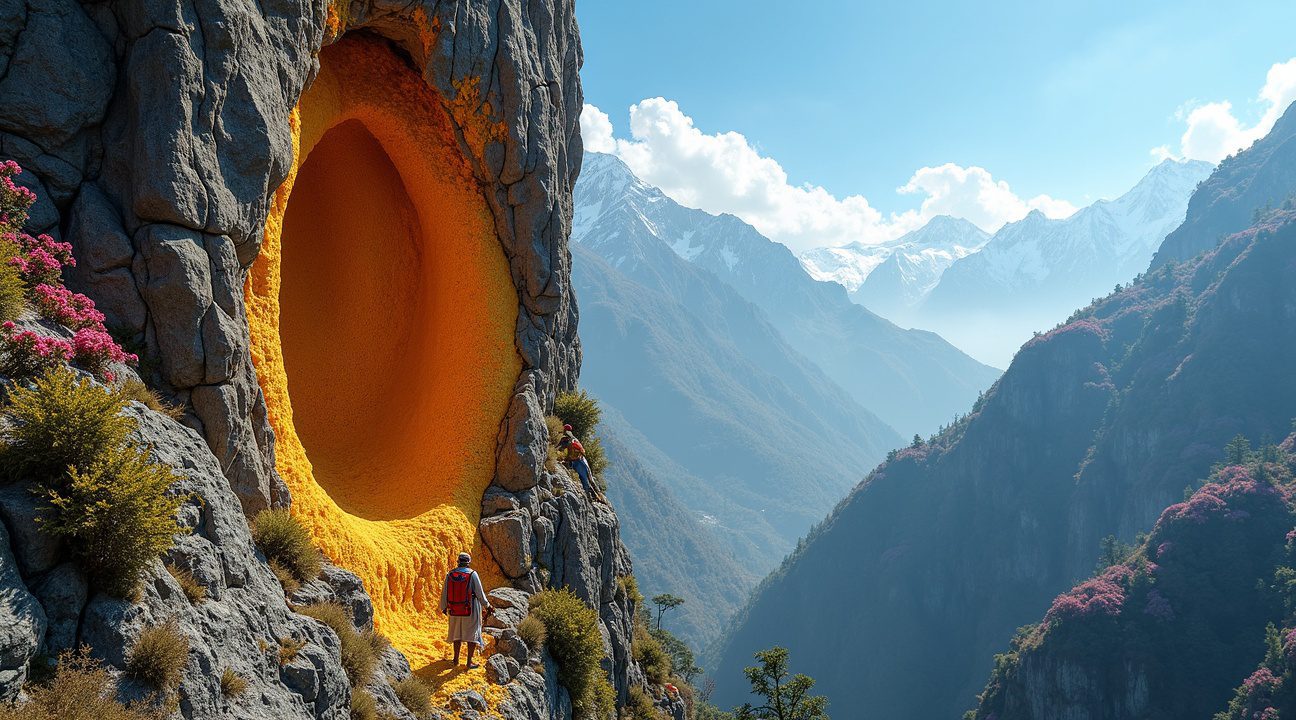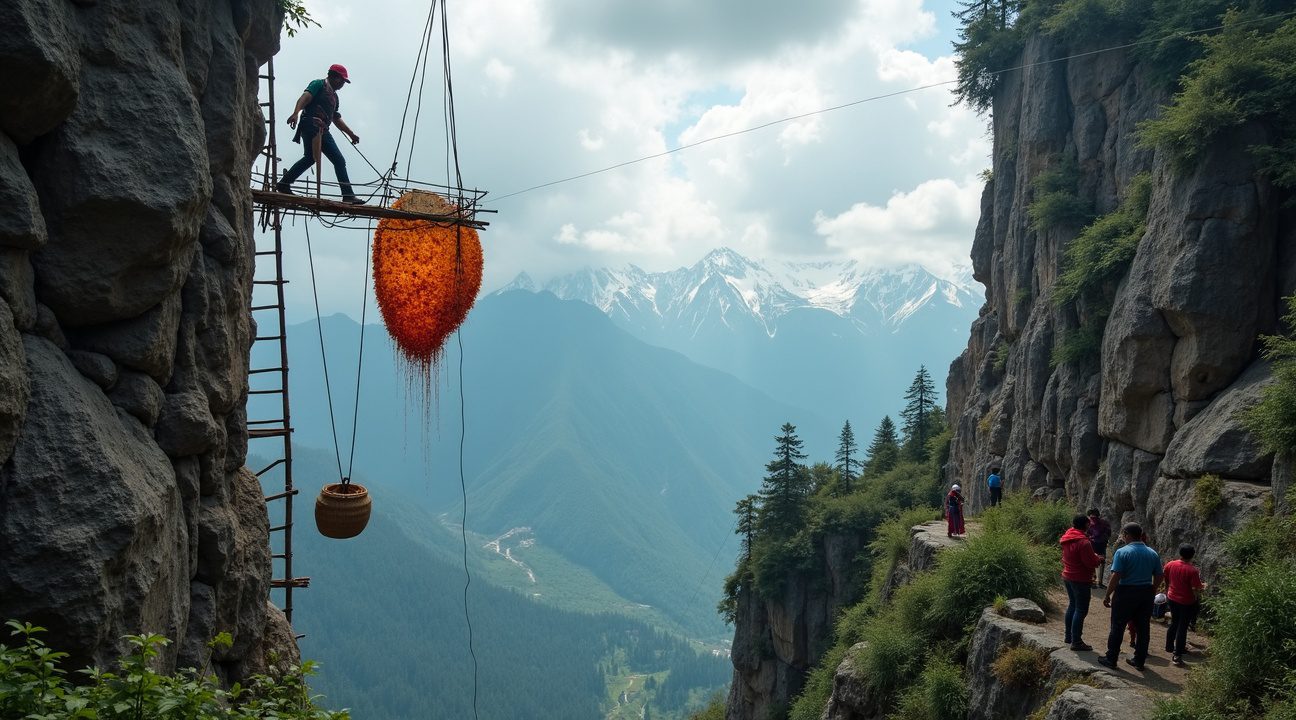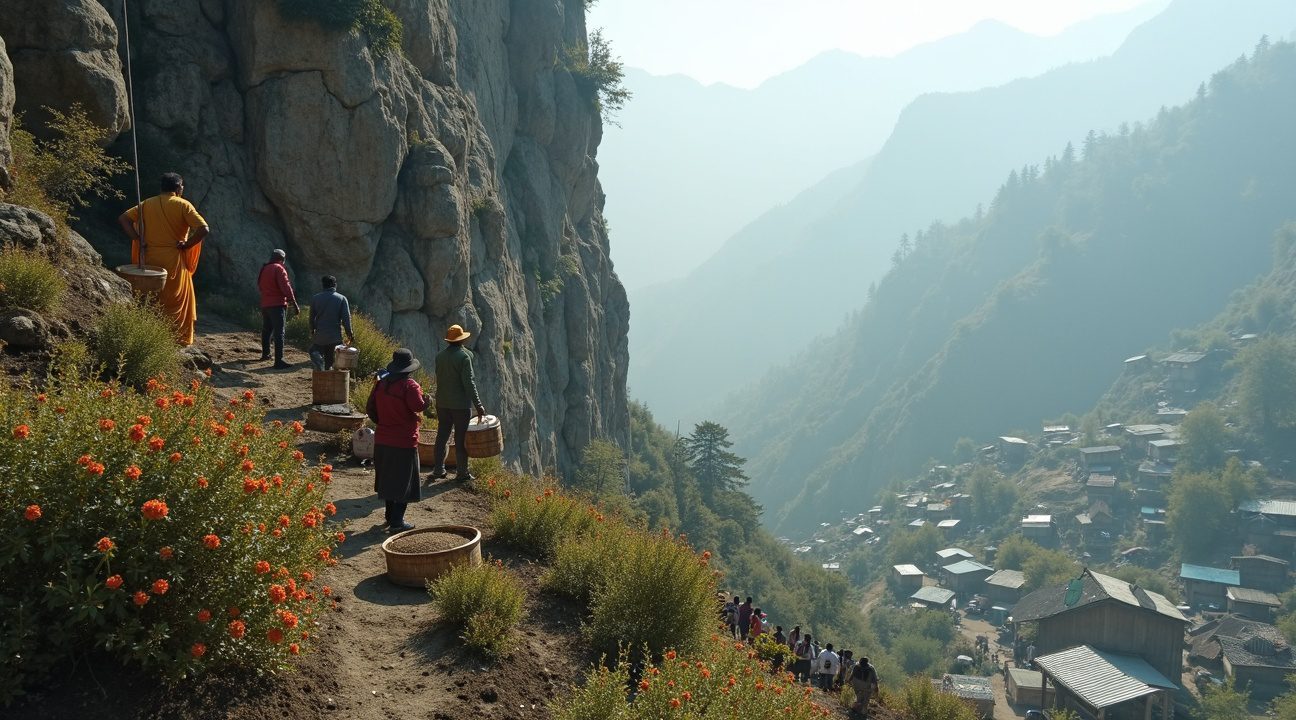Nepal’s mad honey represents one of nature’s most extraordinary phenomena, created by the world’s largest honeybee species, Apis laboriosa, which builds massive cliff-dwelling colonies at altitudes reaching 14,000 feet in the Himalayas.
Key Takeaways
- The Himalayan giant honeybee Apis laboriosa creates mad honey containing grayanotoxins from rhododendron nectar, producing psychoactive effects used in traditional medicine for centuries.
- Traditional Gurung honey hunters risk their lives scaling treacherous cliffs using ancient rope and ladder techniques, though modern commercial pressures are shifting practices toward profit-driven exploitation.
- Mad honey consumption can induce mild euphoria and health benefits in small doses, but higher amounts lead to dangerous symptoms such as bradycardia, hypotension, and life-threatening cardiac issues.
- The giant honeybee population has declined approximately 70% annually due to deforestation, climate change, pesticide use, and unsustainable harvesting practices.
- Sustainable tourism and community-based management offer hope for preserving bee populations and the cultural traditions surrounding mad honey harvesting.
The Creation of Mad Honey
High in the Himalayas, where oxygen runs thin and cliffs pierce the sky, the giant honeybee Apis laboriosa produces one of nature’s most potent substances. These bees build their colonies suspended from sheer rock faces, often so high that clouds drift below them. Their nectar, collected from rhododendron flowers like Rhododendron ponticum and R. luteum, carries grayanotoxins — compounds that act as natural defenses against herbivores.
When bees gather this nectar, the toxins concentrate in the honey, creating what locals call “mad honey”. This honey has intrigued cultures for over two millennia, with varying toxicity based on altitude, seasonality, and flower source. A spring harvest typically yields the strongest honey, known by its darker hue and bitter aftertaste.
Ancient Encounters and Traditional Wisdom
Historical documentation, including writings by Xenophon in 401 BCE, reveal early interactions with mad honey. His soldiers’ accidental consumption caused widespread intoxication, a testament to the honey’s long-recognized psychoactive effects across continents.
The Gurung people of Nepal have passed down knowledge about mad honey harvesting and medicinal use over generations. Their expertise covers seasonal timing, precise dosing, and application in traditional healing practices. Local healers use measured quantities to treat ailments like high blood pressure and digestive disorders, though scientific validation remains limited.
Honey Hunting Rituals
For the Gurung, honey hunting is more than foraging—it’s a sacred tradition. Hunters, known as kuiche, undergo extensive training before attempting the dangerous climbs. They read weather, understand bee behavior, and employ handwoven bamboo ladders and ropes. Smoke from specific plants temporarily pacifies the bees as hunters carefully extract only portions of the hive, maintaining long-term colony health.
Modern Pressures and Environmental Impact
As international demand for mad honey increases, prices have soared to hundreds of dollars per kilogram. This allure has led to increased harvesting, often at the cost of sustainability as entire hives are destroyed for profit.
Combined with habitat loss due to deforestation and climate change, these modern pressures are devastating the giant bee’s fragile ecosystem. Rising temperatures shift flower blooming patterns and reduce nesting sites, while pesticides further threaten hive survival.
The Science of Grayanotoxins
The grayanotoxins found in mad honey affect sodium channels in nerve and muscle cells. Small doses — typically a tablespoon or less — result in sensations like mild euphoria, body warmth, and temporary sensory enhancement.
Yet, exceeding the safe dose quickly leads to mad honey poisoning, with symptoms such as dizziness, nausea, severe bradycardia, and hypotension. Tourists and uninformed buyers are often the most vulnerable, requiring emergency care that may include intensive cardiac monitoring. Recovery is usually quick but may be serious without medical attention.
Gurung practitioners rely on deep familiarity and observe key factors like patient weight and previous tolerance to guide dosing. This contrasts sharply with unregulated commercial sales that ignore these critical safety measures.
Medicinal Applications and Research
Some studies explore beneficial uses of grayanotoxins for cardiovascular health, although scientific consensus is lacking. Anecdotal evidence from traditional healers points to potential applications in treating arthritis, diabetes, and hypertension, but no clinical trials have definitively confirmed these effects.
Efforts Toward Conservation
Several conservation initiatives address both ecological and cultural preservation:
- Community-Based Management: Programs support Gurung villages with sustainable harvesting education and tools to balance traditional practices with modern sustainability goals.
- Ecotourism Initiatives: Some tours permit visitors to witness honey harvesting firsthand, promoting awareness and generating income outside of honey sales.
- Protected Zones: Establishing no-development areas around key habitats helps preserve nesting and foraging grounds for the bees.
- Public Awareness Campaigns: Educating consumers about the risks and ethics of mad honey consumption encourages demand for sustainable, community-produced honey.
Technological and Certification Solutions
Satellite monitoring and GPS mapping allow conservationists to track bee populations and habitat changes. Certification bodies could soon offer verified labeling for sustainably sourced products, providing savvy consumers a way to support ethical and ecological practices.
The Path Forward
The future of Nepal’s mad honey depends on reconciling commercial interest with sustainable harvesting, environmental preservation, and cultural legacy. The Gurung people exemplify balance with nature, offering critical insights for future practices shaped by both tradition and innovation.
Every purchase matters. By choosing products sourced through verified, sustainable channels, consumers empower local communities and ensure the survival of this Asian marvel. With continued collaboration between conservationists, communities, and consumers, Nepal’s mad honey may continue enchanting generations to come.
World’s Largest Honeybee Creates Psychoactive Honey on Himalayan Cliffs
I’ve studied countless honey varieties across the globe, but nothing compares to the extraordinary mad honey produced by nature’s most impressive bee species. The Himalayan giant honeybee (Apis laboriosa) holds the distinction of being the world’s largest honeybee, and these remarkable insects create something truly unique high in the mountains of Nepal.
These massive bees call the southern edge of the Himalayan range home, stretching across roughly 2,500 kilometers of mountainous terrain. What makes this particularly fascinating is that over one-third of their entire population resides specifically in Nepal, making this country the epicenter for mad honey production. Unlike their smaller cousins who build protected hives, these giants construct their homes in some of the most challenging environments on Earth.
Extreme Altitude Living and Massive Cliff Colonies
The nesting behavior of Apis laboriosa defies conventional wisdom about where bees can thrive. I find their choice of habitat absolutely remarkable — these bees establish colonies at elevations reaching up to 14,000 feet, which is approximately 4,000 meters above sea level. They don’t seek shelter in tree hollows or human-made structures like most bee species. Instead, they build their massive, open combs directly on steep, rocky cliff faces where few predators dare venture.
These exposed combs represent architectural marvels in their own right, often reaching widths of 1.5 meters — that’s nearly 5 feet across. The size of these structures matches the impressive stature of their builders, creating natural honey factories suspended on vertical rock walls. Each colony can house thousands of these giant bees, working together to process the nectar they collect from the diverse flora growing at extreme altitudes.
The honey these bees produce gets its psychoactive properties from a very specific source. Grayanotoxins serve as the key compounds responsible for mad honey’s unique effects, and these toxins originate from rhododendron nectar along with other plants belonging to the Ericaceae family. When the giant honeybees forage on these particular flowers, they inadvertently concentrate these naturally occurring compounds into their honey stores.
This creates a fascinating example of how environmental factors directly influence the final product. The specific combination of altitude, climate, and plant species available to these bees results in honey that’s unlike anything produced at lower elevations or in different geographical regions. The concentration of grayanotoxins can vary significantly depending on the season, the specific rhododendron species in bloom, and even the individual foraging patterns of different colonies.
Modern scientific research has helped explain why this honey develops such potent properties. The bees themselves appear unaffected by the grayanotoxins, but mammals experience a range of effects when consuming the honey. This natural phenomenon has been occurring for thousands of years, long before humans understood the biochemical processes behind it.
Traditional Harvesting and Cultural Significance
The harvesting process for this extraordinary honey requires incredible skill and courage. Local honey hunters scale these treacherous cliffs using traditional rope and ladder techniques passed down through generations. They time their harvests carefully, knowing that the potency and flavor of the honey changes throughout the year based on which flowers are blooming and when the rhododendrons are at their peak nectar production.
What strikes me most about this entire process is how it represents a perfect intersection of geography, biology, and human tradition. The Himalayan giant honeybee has evolved to thrive in conditions that would challenge most living creatures, creating a product that has captivated humans for centuries. Their ability to process toxic nectar into something valuable demonstrates nature’s incredible adaptability and resourcefulness.
For those interested in witnessing this remarkable tradition, you can view a fascinating video documentary below:
https://www.youtube.com/watch?v=8gUj8O0U8Ug

The Dangerous Art of Cliffside Honey Hunting
The Gurung people have perfected one of the world’s most dangerous honey harvesting traditions over countless generations. I’ve learned that these indigenous communities, along with other ethnic groups in the Himalayan foothills, risk their lives suspended hundreds of feet above rocky gorges to collect nature’s most potent honey. Their ancient practice involves constructing rope ladders and intricate bamboo scaffolding systems that allow hunters to reach massive cliff-dwelling bee colonies.
Traditional Methods and Seasonal Timing
The traditional honey hunting process follows a precise rhythm that I find fascinating in its complexity. Hunters conduct their expeditions twice yearly, timing their dangerous climbs for late spring and late fall when the bees have produced their richest stores. These experienced climbers use smoke to drive the aggressive Apis laboriosa bees from their hives, creating brief windows of opportunity to harvest the precious combs.
Ancient practices that sustained this tradition for centuries relied heavily on lunar calendar timing and selective harvesting techniques. I’ve discovered that traditional hunters would carefully choose which combs to take, leaving enough for the colonies to survive and rebuild. This selective approach ensured the long-term sustainability of both the bee populations and the honey supply that communities depended upon.
Modern Pressures and Market Transformation
Today’s honey hunting landscape looks dramatically different from its traditional roots. The growing international demand for mad honey has transformed what was once a community-centered practice into a market-driven enterprise. I observe that current harvesting methods often involve taking all available combs regardless of timing, disrupting the natural cycles that previously kept bee populations stable.
This shift has created significant economic opportunities but at considerable cost to traditional practices. Annual exports now reach an estimated 10,000 liters, with a single 250-gram pot commanding prices up to $70 in international markets. Tourism has also become a major factor, as visitors pay substantial sums to witness these death-defying hunts firsthand.
The physical dangers remain as intense as ever. Hunters still face severe bee stings that can cause intense pain and hallucinations, while the constant threat of falls from unstable rope systems adds another layer of risk. I understand that each expedition requires extraordinary courage and skill, as one misstep can result in fatal consequences.
The economic pressures driving modern honey hunting create a complex situation for traditional communities. While increased market value provides much-needed income for remote villages, the rush to meet demand often compromises the sustainable practices that allowed this tradition to flourish for generations. Some communities now harvest during inappropriate seasons or take too much honey, potentially threatening the very bee colonies that make their livelihood possible.
Weather conditions add another variable to an already dangerous practice. Monsoon seasons can make cliff faces treacherous, while unexpected storms can trap hunters on exposed rock faces for hours. The psychological pressure of performing for tourists while maintaining focus on safety creates additional stress for hunters who previously worked solely within their tight-knit communities.
Despite these challenges, many Gurung families continue to pass down their honey hunting knowledge through generations. Young men still learn the intricate skills required to read bee behavior, construct reliable scaffolding, and navigate vertical cliff faces with remarkable precision. This knowledge transfer represents both cultural preservation and economic necessity, as few alternative income sources exist in these remote mountain regions.
The contrast between ancient wisdom and modern market pressures highlights the delicate balance these communities must maintain. Traditional selective harvesting ensured colony survival, while current practices sometimes prioritize immediate profits over long-term sustainability. Finding ways to honor both cultural heritage and economic needs remains one of the greatest challenges facing Nepal’s honey hunting communities today.
To learn more visually about this incredible tradition, you may want to watch the following documentary video:
https://www.youtube.com/watch?v=PnpFBK5eP6w

Psychoactive Effects and Traditional Medicine
Mad honey produces a range of psychoactive effects that have fascinated both researchers and traditional healers for centuries. When consumed in small amounts, this unique honey typically induces mild intoxication and euphoria, creating a gentle altered state of consciousness that many describe as relaxing and pleasant.
However, the line between therapeutic and toxic doses can be dangerously thin. Higher consumption levels trigger more severe physiological responses that can pose serious health risks. Medical documentation reveals that bradycardia, or abnormally slow heart rate, occurs in 88.48% of mad honey poisoning cases. Hypotension affects 76.04% of those who experience toxicity, while additional symptoms include dizziness, nausea, and potentially life-threatening cardiac disturbances.
Mechanism of Action
The psychoactive properties stem from grayanotoxins, naturally occurring compounds found in certain rhododendron species. These potent neurotoxins interfere with sodium channels in cell membranes, disrupting normal electrical signaling throughout the nervous system and cardiovascular tissue. This mechanism explains both the honey’s therapeutic effects and its potential for causing serious poisoning when consumed inappropriately.
Understanding this dual nature is crucial for anyone considering mad honey use. The same compounds responsible for potential health benefits can quickly become dangerous if dosage guidelines aren’t carefully followed.
Traditional Medicinal Applications
Traditional healers in Nepal have incorporated mad honey into their medicinal practices for generations, prescribing it for various health conditions. Common traditional uses include treating:
- Hypertension
- Diabetes
- Sexual dysfunction
- Digestive issues
- Respiratory problems
- General wellness and vitality
Local practitioners believe the honey’s unique properties can address multiple health concerns when administered correctly.
Research into user experiences provides fascinating insights into perceived benefits. In one comprehensive study examining mad honey consumption patterns:
- 77% of users reported experiencing health benefits from their use
- 44.5% of respondents indicated they use mad honey regularly
This suggests a sustained belief in its therapeutic value.
The traditional medicine applications extend beyond these primary uses. Some traditional healers suggest it can boost energy levels and improve overall vitality, though these claims require more scientific validation.
Cultural wisdom surrounding mad honey emphasizes respect for its power and careful attention to dosage. Traditional preparation methods often involve diluting the honey or combining it with other substances to moderate its effects. Experienced practitioners stress that successful therapeutic use depends heavily on understanding individual tolerance levels and starting with very small amounts.
While traditional medicine continues to value mad honey’s potential benefits, modern medical understanding highlights the importance of extreme caution. The narrow margin between therapeutic and toxic doses means that what might provide relief for one person could cause serious complications for another. Factors such as body weight, individual sensitivity, and existing health conditions all influence how someone might respond to grayanotoxin exposure.
Contemporary research efforts aim to better understand how traditional dosing practices might translate into standardized therapeutic applications. Scientists are particularly interested in:
- Isolating specific compounds
- Developing controlled delivery methods to minimize risk
The intersection of traditional knowledge and modern science continues to evolve. While researchers work to validate traditional claims through rigorous scientific methods, practitioners maintain that centuries of careful observation and use provide valuable guidance for safe application. This ongoing dialogue between ancient wisdom and contemporary understanding may eventually lead to more refined therapeutic approaches that honor both traditional practices and modern safety standards.
Mad honey’s role in traditional medicine demonstrates humanity’s long relationship with powerful natural substances. Its continued use reflects both the enduring appeal of natural remedies and the complex challenge of balancing potential benefits against significant risks.
https://www.youtube.com/watch?v=va5DX3PFeJM

Catastrophic 70% Annual Population Decline Threatens Ancient Tradition
I observe a devastating crisis unfolding in Nepal’s remote mountains, where the legendary Apis laboriosa faces an unprecedented threat to its survival. The population of these giant cliff-dwelling bees has plummeted by approximately 70% annually, creating ripple effects that extend far beyond honey production into the very fabric of Nepali culture and economy.
The Perfect Storm of Environmental Pressures
Multiple factors converge to create this ecological disaster:
- Deforestation strips away the flowering trees that bees depend on for nectar.
- Climate change alters blooming cycles and weather patterns that have remained stable for millennia.
- Pesticide use from expanding agricultural operations poisons both bees and their food sources, creating dead zones where colonies once thrived.
- Infrastructure development accelerates the destruction through road construction and hydroelectric dam projects that fragment habitats and contaminate water sources essential for both bees and wildflowers.
- Invasive species compete with native plants, reducing the biodiversity that supports healthy bee populations.
The cumulative impact creates an environment where these ancient pollinators struggle to maintain viable colonies.
Economic and Cultural Devastation
The economic implications strike hard in a country where the average annual income hovers around $1,400. Losses from reduced pollination services cost Nepali farmers approximately $250 per capita, representing nearly 18% of their total yearly earnings. This economic pressure creates a vicious cycle where communities become more dependent on honey harvesting for survival, leading to increasingly unsustainable practices.
Market forces drive overexploitation as international demand for mad honey grows. Traditional harvesting rights have shifted from indigenous communities who practiced sustainable management for generations to government contractors focused on maximizing short-term profits. This transition abandons time-tested conservation practices that once protected bee populations during vulnerable breeding seasons.
The loss extends beyond economics into cultural heritage. Ancient rituals and traditional knowledge systems built around seasonal honey gathering face extinction alongside the bees themselves. Communities that have relied on these practices for centuries now find their ancestral wisdom becoming irrelevant as the bees disappear from cliffs their families have harvested for generations.
Government policies struggle to balance conservation needs with economic pressures, often falling short of protecting either adequately. Without immediate intervention to address habitat restoration, sustainable harvesting practices, and climate adaptation strategies, Nepal risks losing not just its famous mad honey but an entire ecosystem that has supported human communities for thousands of years.
https://www.youtube.com/watch?v=KGEewZAITpI
Economic Pressures and Market Exploitation
International demand for Nepal’s mad honey has fundamentally changed how local communities approach this ancient practice. What once served as a subsistence activity for rural families has evolved into a commercial enterprise driven by global curiosity about this unique psychoactive honey. Export markets now recognize mad honey’s premium value, creating powerful economic incentives that often conflict with traditional sustainable harvesting methods.
Rural communities in Nepal’s mountainous regions face significant economic pressure to increase honey production. Limited alternative income sources leave many families dependent on mad honey sales as their primary means of financial survival. This dependency forces harvesting decisions based on immediate economic needs rather than long-term environmental considerations. Collectors often find themselves caught between preserving traditional practices and meeting the financial demands of modern life.
The shift from community ownership to government contractor control has disrupted centuries-old stewardship practices. Traditional communities maintained natural limits on harvesting through cultural protocols and local management systems. Government contractors, however, operate under different motivations, prioritizing maximum extraction to fulfill commercial contracts. This change reduces local accountability and weakens the community bonds that historically protected bee colonies from overexploitation.
Commercial Exploitation Challenges
Several factors contribute to the unsustainable exploitation of mad honey resources:
- Pricing pressures from international buyers demanding consistent supply volumes regardless of seasonal variations
- Competition between different harvesting groups leading to rushed and destructive collection methods
- Lack of proper training for new commercial harvesters who don’t understand traditional sustainable techniques
- Absence of regulatory frameworks that balance commercial interests with environmental protection
- Limited benefit-sharing agreements that leave local communities with minimal profits despite taking the greatest risks
Export market dynamics create additional strain on Nepal’s mad honey production. International buyers often lack understanding of the complex ecological and cultural factors involved in sustainable harvesting. Their demand for regular supply schedules conflicts with the natural cycles of bee behavior and cliff rose blooming patterns. This mismatch between commercial expectations and ecological reality pushes local harvesters to adopt practices that compromise both safety and sustainability.
The transformation of mad honey from cultural tradition to commercial commodity has introduced new stakeholders with varying interests. While some efforts exist to develop fair trade practices, many rural communities remain vulnerable to exploitation by middlemen and export companies. These intermediaries often capture the majority of profits while local harvesters bear the physical risks and environmental consequences of intensive collection practices.
Modern commercial pressures also affect the quality and authenticity of mad honey reaching international markets. The rush to meet demand sometimes leads to adulteration or mixing of different honey types, diluting the unique properties that originally attracted global interest. This quality degradation threatens both the reputation of Nepalese mad honey and the premium prices that justify the risks involved in its collection.
Economic desperation in remote mountain communities makes resistance to unsustainable practices particularly difficult. When families depend on mad honey income for basic necessities like education and healthcare, conservation concerns often take a secondary role. Without viable economic alternatives or support systems, communities may reluctantly participate in practices they recognize as harmful to their long-term interests.
The challenge lies in developing economic models that provide fair compensation for local communities while maintaining sustainable harvesting practices. Some initiatives focus on premium pricing for certified sustainable mad honey, but these programs remain limited in scope. Creating lasting solutions requires addressing the fundamental economic vulnerabilities that make rural communities susceptible to exploitation in the first place.
Government policies must evolve to better balance commercial opportunities with cultural preservation and environmental protection. Current regulations often favor large-scale commercial operations over traditional community-based management systems that have proven effective for generations. Policy reforms could strengthen local ownership rights while establishing clear sustainability standards for commercial harvesting operations.

Hope Through Sustainable Tourism and Conservation
The future of Nepal’s mad honey industry depends heavily on balancing traditional practices with conservation efforts that protect Apis laboriosa populations. Forward-thinking companies like Best Mad Honey are leading the charge by promoting sustainable tourism initiatives that showcase hive observation experiences while supporting local communities. These programs create economic opportunities beyond honey harvesting alone, giving communities additional revenue streams through guided tours and educational experiences.
Sustainable Harvesting Practices and Economic Diversification
Conservation experts have developed specific recommendations for sustainable mad honey harvesting that can help preserve bee populations for future generations. The most critical guideline involves leaving at least 50% of newly formed combs undisturbed during harvest seasons. Harvesters should only collect portions of the combs rather than entire structures, allowing bees to rebuild and maintain their colonies effectively.
Key sustainable practices include:
- Harvesting only mature sections of combs while preserving developing areas
- Timing collection activities to avoid peak breeding seasons
- Implementing rotational harvesting schedules across different cliff sites
- Training local collectors in conservation-minded techniques
- Monitoring colony health and population trends regularly
Ecotourism presents a promising alternative income source that doesn’t require depleting natural resources. Visitors pay substantial fees to witness the dramatic honey hunting process from safe observation points, generating revenue that can exceed what communities earn from honey sales alone. Agricultural product diversification offers another pathway, with communities developing markets for other mountain products like medicinal herbs, organic vegetables, and traditional crafts.
Currently, no dedicated conservation project exists specifically for Apis laboriosa, despite experts calling for urgent action to prevent further population decline. This gap represents both a challenge and an opportunity for international conservation organizations to step in with funding and expertise. Community-based conservation strategies show the most promise because they integrate traditional knowledge with modern conservation science.
The success of sustainable mad honey production requires combining respect for ancient traditions with practical conservation measures. Local communities possess generations of knowledge about bee behavior and cliff ecology, making them essential partners in any conservation effort. By supporting initiatives that value both cultural heritage and environmental protection, the mad honey industry can continue thriving while ensuring these remarkable bees survive for future generations to appreciate and study.
Sources:
Earth Island Institute: “Nepal’s Embattled ‘Mad Honey’ Bee”
Daily Sabah: “Nepal’s ‘mad honey’ harvest threatened by climate change”
Wikipedia: “Mad honey”
PubMed: “Worldwide distribution and clinical characteristics of mad honey … “
PMC: “Mad honey: uses, intoxicating/poisoning effects, diagnosis, and …”
Wiley Analytical Science Journals: “Grayanotoxins in Mad Honey: Mechanisms of Toxicity, Clinical …”
SciELO Brazil: “Investigation of mad honey use as an alternative treatment in …”


